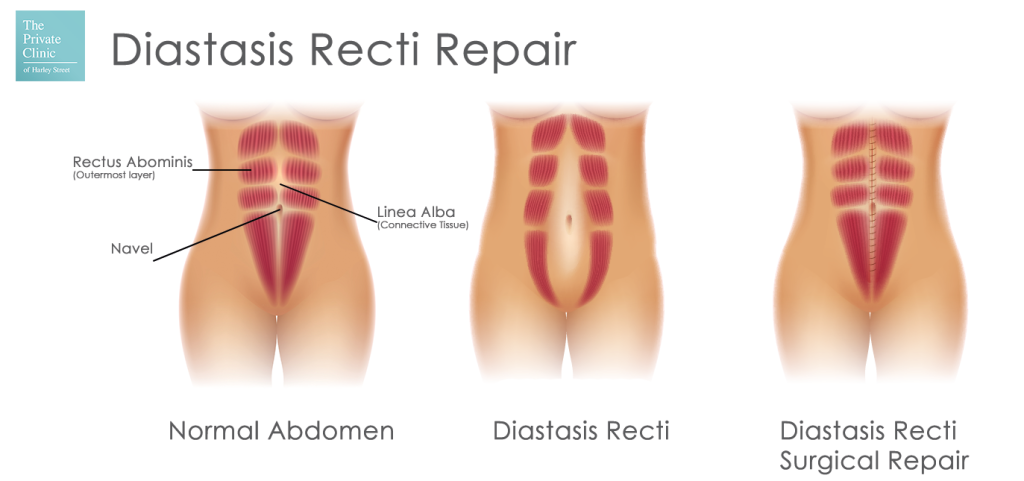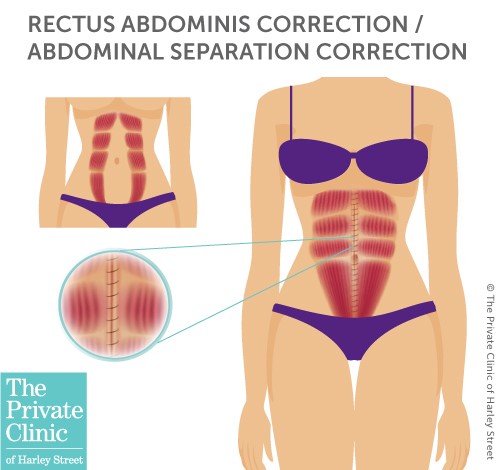
Diastasis Recti Surgery: Tummy Tuck Options
What is Diastasis Recti?
Diastasis Recti is a condition where the rectus abdominis muscles, which run vertically along the abdomen, separate. It is also called DRAM (Diastasis of Rectus Adominis Muscles), abdominal separation, ab gap or simply Mummy Tummy.
Abdominal Separation is most common during or after pregnancy as the abdominal (six-pack) muscles stretch to accommodate the growing baby. Pregnancy hormones can cause the softening of ligaments and connective tissue which can result in abdominal muscle weakness. For some women, the muscles stretch too much and separate along their midline (linea alba). Whilst most pregnant women will experience some form of separation, in most cases, the muscles come back together after pregnancy and do not cause any problems.
However if the tissue has lost elasticity from being over stretched, then the gap within the abdominal muscles will not close as much as it should. This is diastasis recti.
Diasatis Recti can also affect individuals experiencing rapid weight changes or improper lifting techniques.
Types of Diastasis Recti
Diastasis Recti can vary in severity and location.
- Open Diastasis – Full abdominal area
- Above Navel – Separation above the belly button in the upper abdomen.
- Around Navel – Separation mid abdomen around the bellow button.
- Below Navel – Separation lower abdomen below the belly button.
Symptoms
A common symptoms that suggest you might have diastasis recti is when you have a noticeable bulge in your belly and/or a softness or jelly feeling around your belly button. Other symptoms include;
- Coning of doming when the ab muscles are contracted
- Core weakness
- Lower back pain
- Pelvic pain
- Poor posture
- Incontinence
Do I Have Diastasis Recti – How to test for Diastasis Recti?
You can check for diastasis recti on your own, but it is always best to discuss your concerns with your GP or healthcare provider.
To determine if you have Diastasis Recti, you can perform the DRAM test (Divarication of Rectus Abdominis Muscles):
- Lie flat on your back on a solid surface.
- Bend your knees so your feet are flat on the ground.
- Curl your chin in towards your chest and slightly raise your shoulders to engage your abdominal muscles.
- Use your fingers to feel between the edges of your muscles above and below your belly button.
- Gently press down to see if you can feel a gap between your muscles.
- See how many fingers you can fit into the gap, more than two fingers could indicate that separation has occurred.
Treatment Options for Diastasis Recti
It usually takes around 8-10 weeks following childbirth for your stomach muscles to return to normal. If there is still an obvious gap at this time then your muscles may be weaker which can put you at risk of developing complications such as back pain, bloating and incontinence. It is at this time that many may start seeking treatments for diastasis recti.
Non-Surgical Diastasis Recti Treatments
Mild cases of Diastasis Recti can often be managed with exercises and physical therapy. Exercises are focused on strengthening the core without putting excessive strain on the abdominal muscles, while physical therapy involves tailored programs to enhance core stability and muscle tone.
You may also be advised to avoid the following;
- Avoid strenous exercsis that cause your abdominal wall to bulge.
- Avoid straining whilst on the toilet.
- Avoid heavy lifting or bending.
- Avoid sit-ups or crunches.
- Roll onto your side before pushing up to get out of bed.
- Do not wear stomach supports for long periods.
- Avoid holding your baby on one side.
Surgical Diastasis Recti Treatments
For significant muscle separation, surgery is often the most effective solution. Options like a tummy tuck can be beneficial, not only for aesthetic improvements but also for enhancing overall health and quality of life.
How a Tummy Tuck Can Help
A tummy tuck, or abdominoplasty, is a surgical procedure that repairs the separation of abdominal muscles by sewing the two sides of your abdominal muscles back together.
Our team of Consultant Plastic Surgeons are very experienced in providing both structural repairs for diastasis recti as well as achieving a superior cosmetic outcome for the entire abdominal region to ensure you get the best results from your procedure.
It’s also important to remember that surgery cannot teach the muscles how to function properly. After surgery, core training and alignment work will be required to develop true stability and strength and the best outcome.
The best candidates for a tummy tuck are typically those who are finished having children, are at or near their ideal weight, and are in otherwise good health.
Tummy Tuck Options
We offer a variety of tummy tuck procedures to suit individual needs:
- Full Abdominoplasty: Ideal for those with a large amount of excess skin and muscle separation. This procedure repairs muscles, removes excess fat, and tightens the abdomen.
- Extended Abdominoplasty: Best for individuals with excess fat and skin in the flanks and lower back, addressing a broader area and repairing any torn muscles.
- Mini Abdominoplasty: Suitable for patients with minor excess skin and tissue, focusing on the lower abdomen. Read more about choosing between a full or mini tummy tuck here.
- Fleur de Lis Abdominoplasty (FDL Tummy Tuck): Targets excess skin removal from both the upper and lower abdomen, resulting in a smoother appearance.
- Brazilian Tummy Tuck: Combines liposuction with a tummy tuck, ideal for a more sculpted look and quicker healing time.
Can you get Diastis Rectis Repair on the NHS?
Diastasis recti surgery is generally not available on the NHS. After consulting with your GP, physiotherapy is often recommended as the first-line treatment which may include regular pelvic floor and deep stomach muscle exercises. To be referred for Diastasis recti repair surgery you would need to have tried core training physiotherapy for at least 6 months. There is a strict list of criteria which patients must meet which includes having significant functional impairment caused by diastasis recti. Diastasis recti repair would not be offered for cosmetic purposes alone.
Can You Prevent Diastasis Recti?
While not entirely preventable, certain measures can help reduce the risk:
- Engage in Safe Exercises: Strengthen your core without overstraining.
- Practise Good Posture: Maintain a healthy posture to reduce abdominal stress.
- Manage Weight: Keep a healthy weight to minimise pressure on the abdomen.
The Mummy Makeover
A Mummy Makeover offers a personalised approach to help you reclaim your pre-pregnancy body. Designed to address the physical changes after childbirth, this comprehensive package allows mothers to restore their bodies to a comfortable and confident state.
Our experienced surgeons collaborate with you to create a tailored plan, which may include procedures such as a tummy tuck, breast enhancement, or liposuction. These treatments can be performed together or in stages, depending on your needs and lifestyle.
Many women find that a Mummy Makeover not only enhances their physical appearance but also boosts their self-esteem and mental well-being. By focusing on both aesthetic and emotional recovery, our team is dedicated to supporting you through this transformative journey.
Whether you’re dealing with stubborn areas resistant to diet and exercise or seeking to address Diastasis Recti, we are committed to helping you feel empowered and rejuvenated. Explore the possibilities of a Mummy Makeover and learn how we can help you become the best version of yourself. For more information, click here.
Diastasis Rectis FAQs
What are the risk factors for developing diastasis recti?
There are some factors which can increase your risk of developing diastasis recti. These include:
- Multiple Pregnancies
- Carrying a heavy baby
- Having a petite frame
- Being over 35 years old
- Carrying twins or multiples
- Vaginal Delivery
Can you get diastasis recti more than once?
Diastasis Recti repair surgery is best performed on patients who have completed their family. Overall, surgical repair is permanent but your risk for diastasis recti increases each time you become pregnant.
Will I feel the sutures used during diastasis recti surgical repair?
The sutures used to repair your abdominal muscles are placed deep beneath your skin and buried within the fascia. You should not be able to feel them.
Is it too late to fix my diastasis recti?
Diastasis recti can be repaired years after child birth, there is no defined time limit.
Are planks bad for diastasis recti?
Yes, plank-style exercises can be bad for abdominal separation. When returning to exercise with diastis recti, it is best to speak to a professional so you are not excessively straining the abdominal muscles.
At The Private Clinic, our experienced surgeons are dedicated to helping you choose the best treatment plan for your needs. Whether considering surgery or exploring other options, we are here to guide you every step of the way. For more information or to schedule a consultation, visit our website at The Private Clinic or call 0333 920 2471.
Tummy Tuck Experts
- Mr William Van Niekerk, MB ChB, MSc, MRCS, FRCS (Plast), FCMI, RAF (qs). GMC Number: 4362791
- Ms Helena Antoniadou, MBBS, MD & Surg (Hons), FRCS (Eng). GMC Number: 3700956
- Mr Maisam Fazel, MA(Cantab), MB BChir, MSEd, FRCS. GMC Number : 4767420
- Mr Giuseppe Di Taranto, MD. GMC Number: 7614248
- Professor Sandip Hindocha, MD, MPhil, MBChB, MRCS, MFFLM, FRCS (Plast). GMC Number: 6122218
- Ms Rieka Taghizadeh, MBChb, MRCS (Glas), FRCS (Plast), GMC Number: 4743910
- Mr George Samouris, MD. GMC Number: 7064009
Sources
-
NHS – Your post-pregnancy body
-
Web MD – Abdominal Separation (Diastasis Recti)
-
Healthline – Diastasis Recti: What Is It, and How Is It Treated?
-
American Society of Plastic Surgeons – What is diastasis recti? And how can a tummy tuck help?









